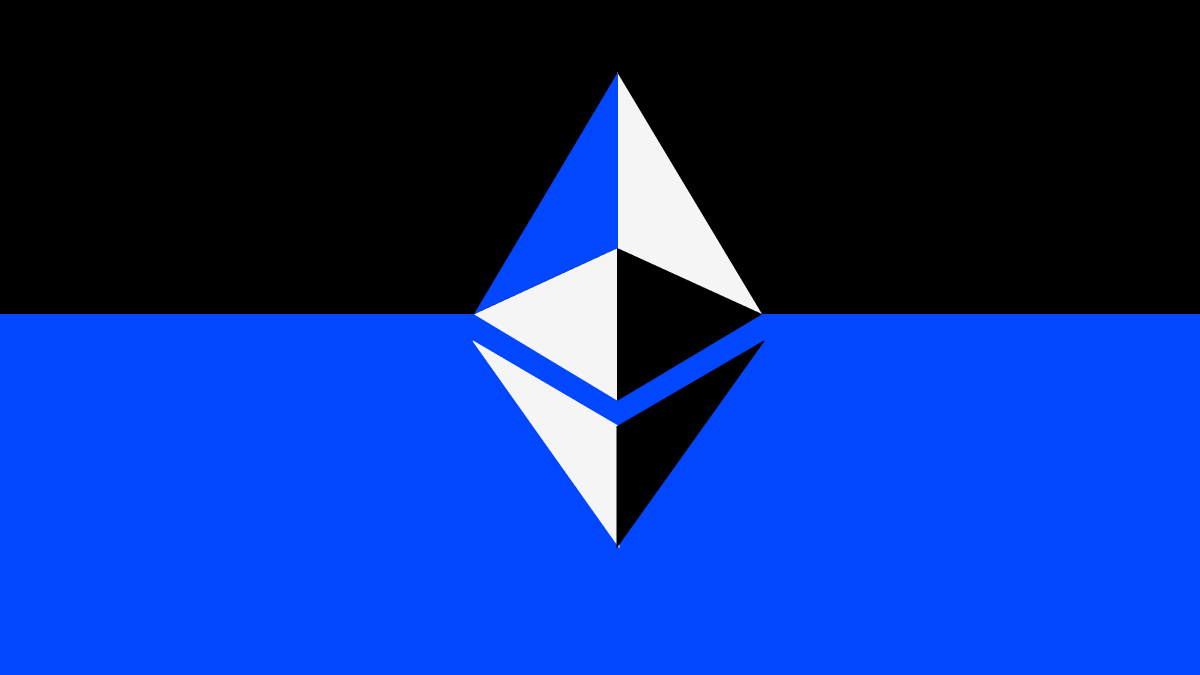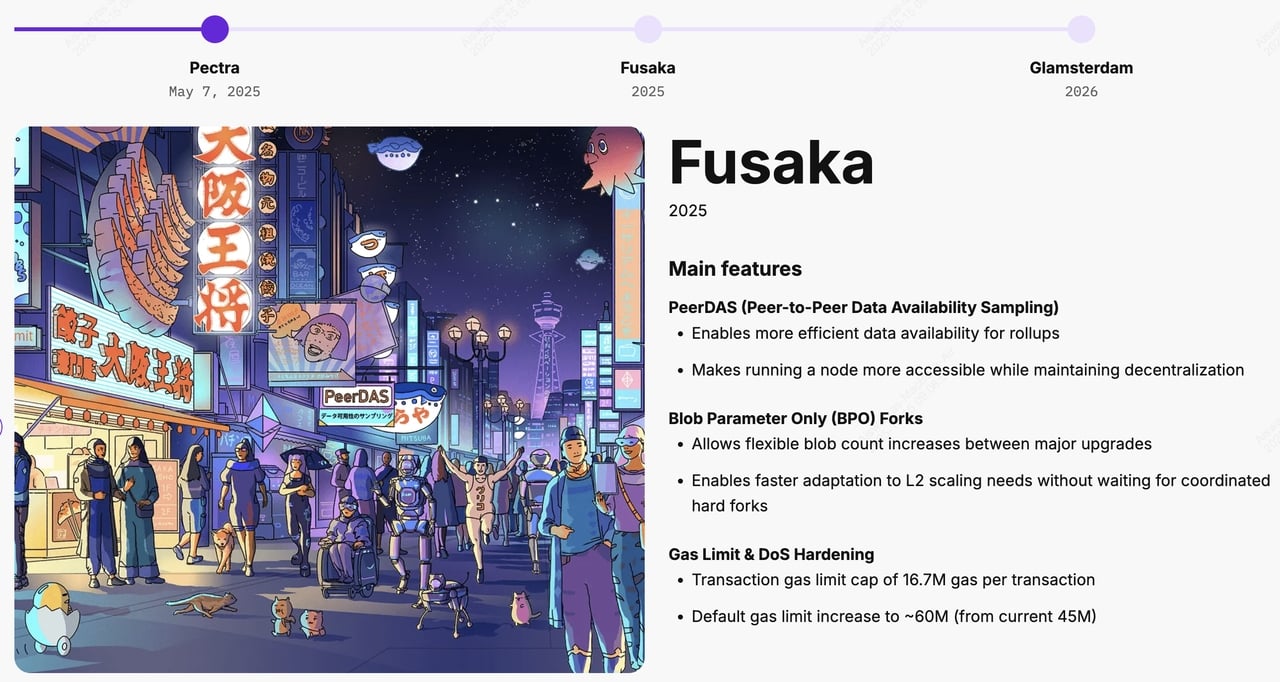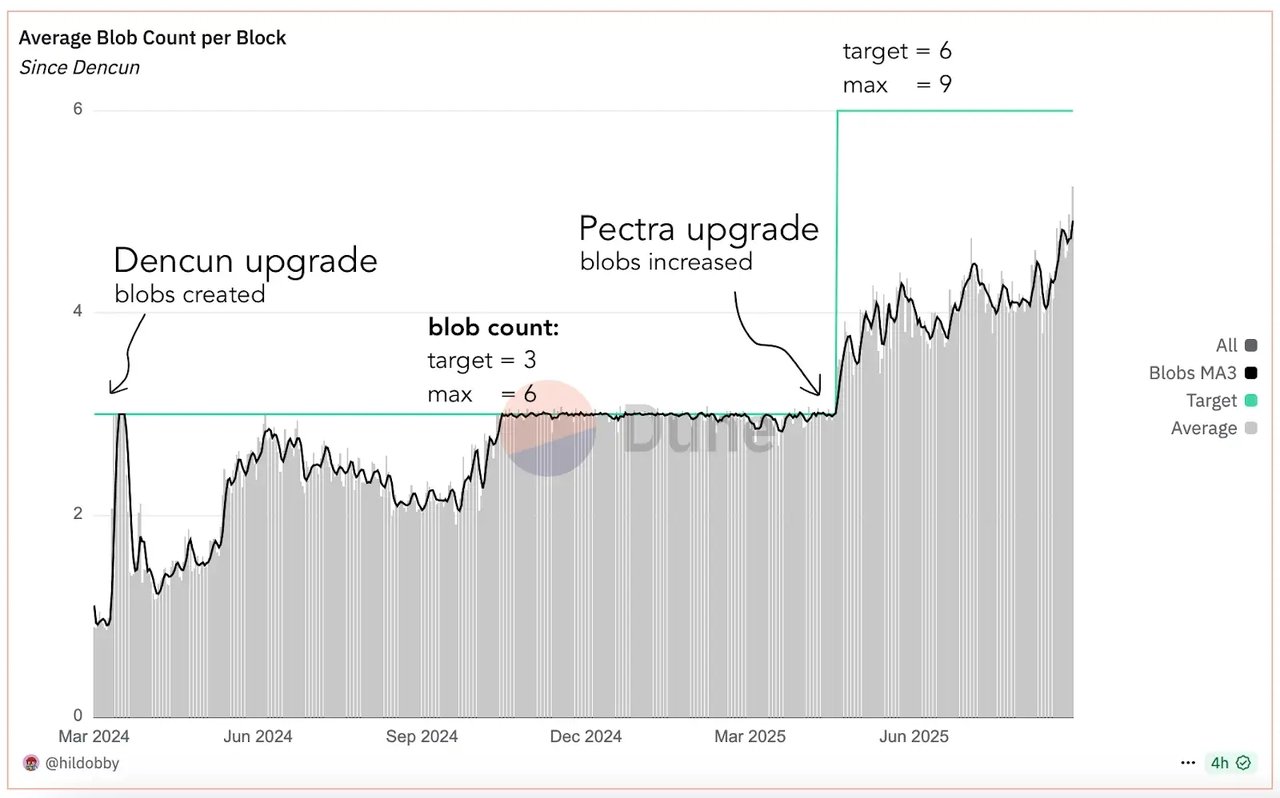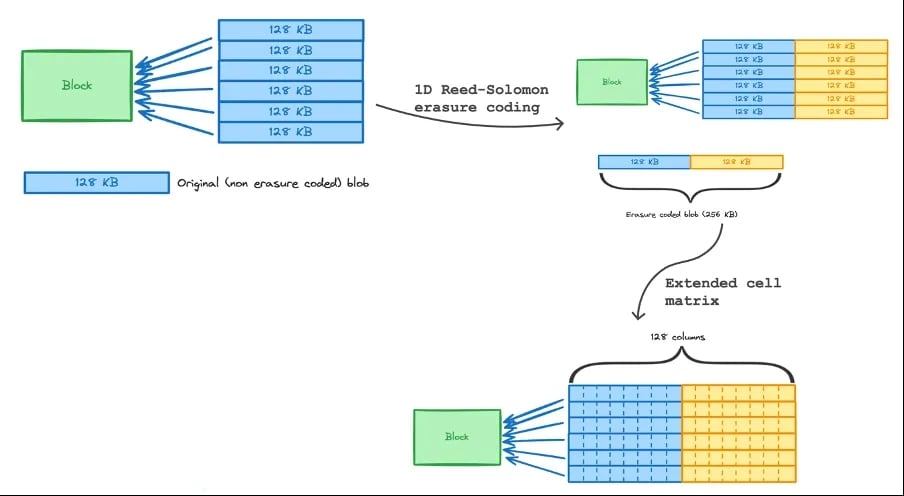Activated across public testnets through October and aiming for a December 3, 2025 mainnet release, Fusaka is
Ethereum’s next major upgrade after
Pectra, designed to boost rollup scalability while keeping network nodes efficient. It introduces Peer Data Availability Sampling (PeerDAS), coordinates Blob-Parameter-Only (BPO) mini-forks to raise blob capacity between major hard forks, and adjusts the default block gas limit to around 60 million via EIP-7935. Together, these changes aim for cheaper
Layer-2 transactions, smoother node operations, and a safer path to higher throughput.
By the end of this guide, you’ll understand what Ethereum Fusaka update is, how PeerDAS improves scalability, when it’s rolling out, and how users, developers, and investors can prepare for Ethereum’s next major evolution.
What Is the Ethereum Fusaka Upgrade?
Ethereum Fusaka upgrade roadmap and key features | Source: Ethereum.org
Fusaka, informally combining “Fulu + Osaka,” is a coordinated bundle of roughly a dozen EIPs aimed at scaling
Ethereum’s
data availability and execution capacity, especially for L2 rollups that publish data “blobs” to L1. The headline feature is PeerDAS (EIP-7594), which lets nodes sample small parts of rollup data from peers instead of downloading every blob in full, drastically reducing per-node bandwidth and enabling more data space over time.
Beyond PeerDAS, Fusaka packages BPO (Blob-Parameter-Only) forks that can raise blob targets/max without a full hard fork, plus safety hardening, e.g., caps on per-tx gas and physical block size, and developer niceties like secp256r1 precompile and a CLZ opcode for cheaper on-chain math. Client defaults for gas limit are also coordinated to about 60M via EIP-7935.
When Is the Fusaka (Fulu + Osaka) Upgrade Launching?
The Ethereum Fusaka upgrade is being deployed in three test phases before its official mainnet launch in December 2025. Each testnet activation allows developers to verify stability, performance, and compatibility before the upgrade goes live across the entire network.
1. Holesky Testnet — Activated on October 1, 2025 (UTC): The first rollout successfully tested the basic features of Fusaka, including block gas limit changes and validator performance.
2. Sepolia Testnet — Activated on October 14, 2025 (UTC): The second test focused on PeerDAS, Ethereum’s new data-sampling system, and simulated higher gas limits to ensure nodes could handle the upgrade smoothly.
3. Hoodi Testnet — Scheduled for October 28, 2025 (UTC): This will be the final rehearsal before mainnet activation. Developers will monitor how PeerDAS interacts with real-world network conditions and verify system safety at full capacity.
If all tests go as planned, the mainnet activation is targeted for December 3, 2025, marking the official launch of Fusaka. Core developers will confirm the exact block slot and epoch closer to the date once all client teams complete stability checks and final synchronization.
What Changes in the Ethereum Ecosystem After the Fusaka Upgrade Rollout?
Average blob count per block on Ethereum network | Source: Ethereum.org
The Fusaka upgrade is a major scalability milestone that will make Ethereum faster, cheaper, and safer for everyone from rollup developers to everyday users. Here are the key improvements this update could bring:
• Cheaper Layer-2 transactions: Rollups like Arbitrum and Optimism post transaction batches to Ethereum as “blobs.” With PeerDAS, each node checks only ~12.5% of blob data instead of the entire file, reducing workload and cutting rollup posting fees.
• Gradual capacity expansion: Mini BPO forks after mainnet launch planned for Dec 17, 2025 and Jan 7, 2026 will gradually raise blob capacity from 9 to 15 and then to 21, ensuring safe scaling.
• Network efficiency and safety: Client defaults around 60 million gas (EIP-7935), along with per-transaction caps and a 10 MiB block size limit, prevent network overload while boosting throughput.
Key EIPs in the Fusaka Upgrade and What They Mean for You
The Fusaka upgrade bundles several Ethereum Improvement Proposals (EIPs) that work together to improve scalability, efficiency, and developer experience. Here are the most important ones to understand and why they matter:
1. EIP-7594: PeerDAS (Peer Data Availability Sampling)
This is the core feature of Fusaka. It changes how Ethereum verifies rollup data by allowing nodes to check small samples instead of downloading full data blobs. This dramatically reduces bandwidth use, allowing the network to fit more rollup data per block and lower Layer 2 transaction fees on chains like Arbitrum, Optimism, and Base.
How PeerDAS Works and Why It Matters for the Fusaka Update
An overview of PeerDAS's mechanics | Source: Medium
Right now, every Ethereum node has to download all the rollup data (called blobs) to make sure it’s valid and available. This system works, but as Layer 2 networks like
Arbitrum and
Optimism post more data, it puts heavy bandwidth and storage pressure on nodes. The result is slower syncing, higher hardware costs, and limits on how much the network can scale.
The PeerDAS system (EIP-7594) changes this by introducing data sampling. Instead of downloading everything, each node only checks a small, random portion of the blob data, about 12.5% (1/8) per node under current specs. When enough nodes verify their samples and all look good, Ethereum can confidently confirm that the entire dataset exists. It’s like having hundreds of reviewers each read a few pages of a book instead of everyone reading the whole thing.
This innovation is a game changer for scalability. By reducing how much data each node must handle, Ethereum can safely raise the total data capacity through upcoming BPO forks. More capacity means lower rollup fees, faster transactions, and fewer bottlenecks during busy times. For users, this translates to cheaper swaps, mints, and bridges on L2s, and for developers, it opens the door to building even more complex, data-rich applications.
2. EIP-7892: BPO (Blob-Parameter-Only) Forks
Instead of waiting months for another big hard fork, BPO forks let developers raise blob capacity gradually right after Fusaka. Two mini-upgrades are already scheduled, on Dec 17, 2025 and Jan 7, 2026, which will increase the maximum blob count from 9 to 15 and then from 15 to 21. This ensures steady growth in data space while keeping the network stable between steps.
3. EIP-7935: Default Gas Limit Around 60 Million
To handle the extra throughput, most Ethereum clients will move from a 36 million to 60 million gas limit. This isn’t a strict rule but a coordinated setting across clients like Geth, Nethermind, and Erigon. It boosts block capacity while new safety caps prevent any single transaction from clogging the chain.
Other Safety and Performance Improvements
Several smaller EIPs focus on keeping the network secure and efficient as activity ramps up:
• Per-transaction gas cap and 10 MiB block size cap prevent giant blocks from slowing the network.
• Bounded blob base fee and MODEXP gas adjustments stabilize transaction costs during heavy computation.
• Deterministic proposer lookahead gives validators advance notice of upcoming blocks, helping L2s achieve near-instant confirmations.
These updates make Ethereum’s infrastructure more resilient, predictable, and affordable for all participants.
Developer Experience Upgrades
Fusaka also brings quality-of-life improvements for builders:
• secp256r1 precompile: Enables wallets to use biometric authentication like Face ID or passkeys, making onboarding safer and simpler.
• CLZ opcode: Reduces gas costs for complex math calculations, especially in ZK-proofs,
DeFi protocols, and gaming dApps.
Together, these tools make Ethereum more developer-friendly and open the door for next-generation smart contract designs.
How Does Ethereum's Fusaka Upgrade Impact Different Stakeholders?
For Layer-2 and app developers, Fusaka brings lower data costs and faster posting times, along with new tools like secp256r1 for biometric wallets and CLZ for gas-efficient smart contracts. Monitoring blob usage will help optimize performance.
For node operators and validators, upgrading both execution and consensus clients before December 3 is essential. After the upgrade, operators should monitor block propagation, missed slots, and blob fee metrics to ensure stability. For everyday users, no action is required, but you can expect lower, more stable fees when swapping, minting, or gaming on Layer-2 networks as blob capacity expands.
How to Prepare for the Ethereum Fusaka Upgrade
The Fusaka upgrade is one of Ethereum’s biggest scalability milestones yet, and while most of the technical work happens behind the scenes, it helps to know how you can prepare depending on your role in the ecosystem.
• For Ethereum Users: No manual action is needed. Just make sure your wallet or dApp interface is updated to the latest version. After the upgrade, you’ll automatically benefit from lower Layer-2 fees, faster transactions, and a smoother experience when swapping or minting
NFTs.
• For Developers and Node Operators: Upgrade your execution and consensus clients before December 3, 2025, to ensure network compatibility. Test your applications on Hoodi testnet before launch, monitor blob usage metrics, and prepare to leverage new tools like PeerDAS, secp256r1, and CLZ for better scalability and user experience.
• For ETH Investors and Stakers: Stay informed on mainnet rollout progress and BPO fork schedules. Fusaka’s improvements in data efficiency and rollup adoption could strengthen Ethereum’s long-term demand and fee revenue, making it a key event to watch for market trends and staking yields.
What Are the Risks and Trade-Offs of the Fusaka Mainnet Upgrade?
While Fusaka is a major step forward for Ethereum’s scalability, it also introduces new design trade-offs that users, developers, and validators should be aware of.
1. Centralization risk in data storage: PeerDAS reduces how much data each node must download by letting them check only small random samples. However, a smaller group of “full data” nodes, usually run by infrastructure providers or staking operators, must still store everything to keep the network secure. If too few of these exist, it could concentrate power and reduce decentralization. To avoid that, Fusaka includes safety measures like fee bounds, gas caps, and gradual blob increases to maintain a healthy balance.
2. Controlled gas limit increases: You may hear rumors about Ethereum’s gas limit jumping to 150 million, but that’s not the case. Under EIP-7935, Fusaka only aligns client defaults around 60 million gas, ensuring more capacity without stressing the network. Any further increases will depend on real-world testing and stability data, preventing overloads and keeping node participation accessible to everyone.
What’s Next After the Fusaka Upgrade on the Ethereum 2.0 Roadmap?
With Fusaka delivering PeerDAS and BPO forks to expand Ethereum’s data capacity, the network will move into its next roadmap phase, “Glamsterdam”, expected sometime in 2026. This upgrade will focus on refining scalability, improving user experience, and enhancing validator efficiency following the large-scale data improvements introduced by Fusaka.
Key priorities for Glamsterdam include further optimizing danksharding, improving MEV (Maximal Extractable Value) fairness under The Scourge phase, and simplifying node operations under The Verge and The Purge initiatives. Together, these upgrades will continue to reduce costs for Layer-2 networks, streamline wallet interactions, and make Ethereum more sustainable for long-term growth.
Conclusion
The Fusaka upgrade is a cornerstone of Ethereum’s long-term scaling roadmap. By combining PeerDAS, BPO forks, and gas optimization, it delivers a safer, faster, and cheaper foundation for rollups and decentralized apps.
However, as with all major network upgrades, users and node operators should stay updated, monitor network performance, and prepare for short-term volatility. With Fusaka paving the way for Glamsterdam and beyond, Ethereum continues evolving toward a future of high throughput, low fees, and secure global decentralization.
Related Reading




